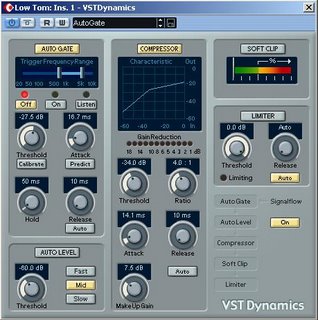To begin at the beginning. I will take this one step at a time, because it is the easiest way to show what we've done. We've got 8 tracks for the drums, i.e. :
1) Bassdrum
2) Snare
3) Hihat
4) High Tom
5) Mid Tom
6) Low Tom
7) Overhead #1
8) Overhead #2
1) Bassdrum
At first I've used the multibandcompressor which comes with Cubase SX3. In this plugin there is a preset for bassdrums. I altered this preset a little to make the kick stand out a little more. The low frequencies are boosted a little bit around 1.0 on top of the settings. This to get a little more kick to it. After this I've used the noisegate which is included in the VST dynamics which is also included in Cubase. I gate this using the autogate preset, but adjusting the treshold and the attack and release to get a big attack and a short release. After this, is EQ-ing baby!!
The EQ in this particular thing is very limited in my opinion. I use a boost around the 100 Hz with a big Q (around 9) and a boost with a low Q (0.2) in the 1 - 3 kHz section. Just move around a little, you'll hear when it sounds good. Boosting these regions means it is going to interfere with the bassguitar, so you got to cut these regions there, but that's for a later concern. Why boost these frequencies? If you have a simple audio system (for example a car stereo or mp3-player) it doesn't get all the low frequencies, therefor you will lose all sense of a bassdrum. It's just gone! That can't happen ofcourse.

2) Snaredrum
It's a pity it's only one track. Even now I still feel we should have needed a snare bottom track, but that though and we'll have to work with it. Ok, back to business. Compressing the snaretrack is done in a similar as the bassdrum, but then use the snare preset and boost the upper regions, but again just a little, not too much. Gating this isn't that complicated either, use the autogate function in VST dynamics and place the treshold in a way you hear enough, same goes for attack (rather big) and release (short). EQ-ing is different for every song. One song needs a low pounding snare, while the other one needs a high whacking sound. So use your imagination here.
3) High, Mid and Low Tom
All three? Yep, all three, because they're basically the same thing. In all honesty I'm not totally happy with the sound I have now, so this probably is going to be altered in the near future. At first I used the compressor and boosted the low regions with 2.5 and the higher regions with 1.0, after that I altered the characteristics a bit. Then gating is the real problem, well in my opinion. I used the gate with a big attack and a short release, but the sound I get isn't really satisfying. I'll get back to this when I've found out a good setting.
Panning the toms is cool ofcourse and therefor I've panned the high tom to the left, mid tom center and low tom to the right. Do not go to extremes panning these things. It gives the listener the idea that the drums are as wide as an entire stage.
Update:
Ok. I've been messing around quite a bit now and I've found a few settings which work great for me. First I gate the whole shebang with a big attack, small release and a hold around the 50 ms. After this I use the compressor in the VST dynamics plug-in and use a 4.0 : 1 ratio, same attack and release and a boost in the gain. It looks something like this.

This works fine for me, so therefor I do it like this. Sue me!
4) Overheads
First I panned Overhead #1 to the hard left and Overhead #2 to the hard right to create the sense of space. After that I've used a compressor and the preset for an entire drumtrack. After that I boost the upper regions of the frequencies to a satisfying pitch of crashes and that's it for editing tracks.
5) Mixing the whole shebang
Make sure the bassdrum and snare are well heard and if you choose to use the hihat track, you can boost the EQ between the 9 and 12 kHz with a big Q to give a better sound to it. Then find a passage in the song in which the crashes are being hit. Slowly bring up the overheads to a level at which you can distinctly hear the crashes, but they don't overshadow the whole drumtrack. After this you can bring up the toms to a satisfying level, but make sure it doesn't get the main attention in the drumtrack. Bassdrum and snare are the instruments which supply the rhythm. Good luck and I'll get back to you when the tom's are well mixed in my songs.
No comments:
Post a Comment